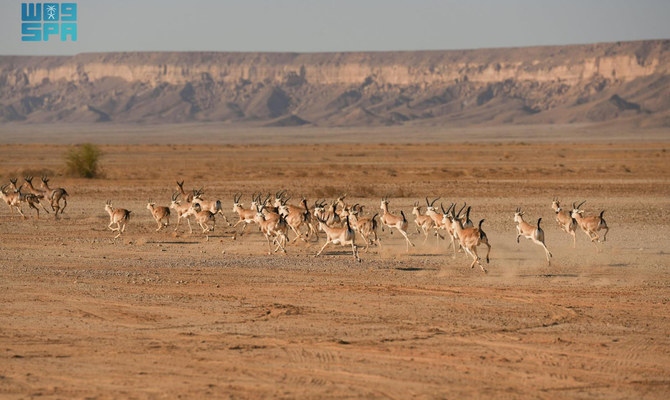Restoring ecological balance through conservation of native species

https://arab.news/2fy79
As we endeavor to rebalance the ecological scales, we find there are no quick fixes for restoring our planet’s health. It cannot be achieved in a day, a month or even a year. It requires the relentless dedication of the brightest of minds and the most passionate of hearts, a tireless spirit, and a commitment to long-term goals.
Regeneration is a slow process and the time to act is now. This principle of immediate action to safeguard and rejuvenate flora and fauna underpins the ecological regeneration initiatives underway in AlUla, and across Saudi Arabia more broadly. In tandem with its evolution as a luxury boutique heritage destination, AlUla has consistently focused on land restoration to reclaim the ecological balance it once had, while ensuring benefits for the local community.
AlUla has set aside 12,500 square kilometers to create six nature reserves: Sharaan, Wadi Nakhlah, Gharameel, Harrat Uwayrid, Harrat AlZabin and Harrat Khaybar. This allocation represents more than 50 percent of the region’s total area. The identification of more than 500 species of flora in AlUla underscores its rich biodiversity and diverse landscapes.
The Kingdom is also actively reintroducing native animal species to their natural habitats, enhancing biodiversity and contributing significantly to the revitalization of AlUla’s ecological cycle. Since 2019, these efforts have been supported by scientific insights and strategic refinements. AlUla monitors animal populations and collects data, adhering to international standards and collaborating with organizations such as Panthera and the International Union for Conservation of Nature to ensure their conservation initiatives are effective and sustainable.
In 2023, the Royal Commission for AlUla achieved a significant milestone with its largest-ever release of about 1,000 animals across three nature reserves. This initiative focused on reintroducing four native herbivore species: Arabian gazelle, sand gazelle, Arabian oryx and Nubian ibex.
By taking decisive action now, AlUla is not just planning for its future as a global destination but is actively securing a brighter, more sustainable future for the planet.
Jose Ferreira
This strategic reintroduction of large herbivores represents a critical step in reconstruction of the ecosystem, setting the stage for the eventual reintroduction of the critically endangered Arabian leopard.
AlUla operates a state-of-the-art breeding center that has enjoyed remarkable success. In 2023, the center celebrated the birth of seven leopard cubs and has effectively doubled the captive-breeding population from 14 to 27 over the past two years. This growth is a hopeful sign for the survival of this majestic species.
This ongoing effort is part of a broader vision for AlUla that aims for holistic and sustainable regeneration. It is an approach that integrates the protection and revival of ancient heritage sites with the development of a vibrant natural habitat. It also ensures that indigenous plants and animals will coexist with new infrastructure such as hotels, homes, schools and community centers.
The exemplary integration of heritage and nature is showcased through AlUla’s Hegra Wildlife and Nature Tour. This safari-style experience allows visitors to immerse themselves in the stunning landscapes and diverse wildlife near Saudi Arabia’s first UNESCO World Heritage site, illustrating the practical and inspirational reasons behind AlUla’s conservation efforts.
These endeavors are not only about preserving the past but also about shaping a sustainable future, contributing significantly to the goals of Saudi Vision 2030. By taking decisive action now, AlUla is not only planning for its future as a global destination, it is actively securing a brighter, more sustainable future for the planet and all its inhabitants.
• Jose Ferreira is the conservation breeding and reintroduction director at the Royal Commission for AlUla, with a principal focus on the Arabian leopard.






























